Film production has long faced challenges in maintaining character and scene continuity, particularly when using AI-generated content. The advent of AI in the film industry has introduced new possibilities and tools that promise exceptional creativity and innovation, yet it also presents a significant challenge: character consistency across multiple scenes. Addressing this issue has been a daunting task for many developers, but Runway AI Inc.’s latest model, Gen-4, aims to solve these issues and revolutionize the industry. By ensuring that character portrayal remains stable throughout the narrative, Gen-4 marks a significant milestone in AI technology, which could transform traditional filmmaking processes.
Gen-4’s Breakthrough in Character Consistency
Runway AI Inc. has tackled the critical obstacle of achieving consistent character portrayal across various scenes with their Gen-4 model. The technology harnesses sophisticated algorithms to recall and incorporate a persistent memory of visual elements, ensuring once a character, object, or environment is established, it can be rendered from different angles while maintaining its essential attributes. This approach overcomes the common problem of treating each video frame separately, which often leads to inconsistencies and a disjointed visual narrative. The breakthrough holds promise to not only enhance visual continuity but also allow filmmakers to craft coherent and captivating stories.
Incorporating persistent memory within Gen-4 represents a significant leap from creating visually interesting snippets to telling comprehensive and engaging narratives. Traditional AI models typically handle each frame as an isolated task, which often results in characters and scenes that appear disconnected from one another. Gen-4 addresses this by establishing a seamless continuity among scenes, allowing filmmakers to present their stories with consistency akin to human-directed films. As AI evolves to overcome these technical hurdles, the film industry stands on the brink of a transformative change where artificial intelligence can significantly enhance the storytelling experience.
The Impact of Gen-4 on Storytelling
For filmmakers, the introduction of Gen-4 unlocks new creative possibilities, enabling the production of coherent stories with AI-generated visuals that maintain character and scene consistency from different angles. This advancement signifies a transition from creating fragmented snippets to crafting meaningful visual narratives. Runway has showcased this potential through short films like “New York is a Zoo” and “The Retrieval.” These films exemplify the capabilities of Gen-4 by placing realistic animals in cinematic New York settings and depicting explorers searching for a mysterious flower, respectively.
These demonstrations underscore how Gen-4 can facilitate the creation of visually compelling and narratively coherent films. By maintaining consistency in characters and environments, filmmakers can focus more on the creative aspects of storytelling rather than the technical challenges. This technology does not merely allow the generation of believable scenes but helps in constructing a fluid and engaging narrative that can resonate with audiences. The impact on storytelling is profound, as AI-generated visuals continue to evolve and integrate into mainstream film production, offering an innovative approach to achieving artistic and narrative coherence.
Technological Foundations and Innovations
The development of Gen-4 builds upon Runway’s previous innovations, showcasing a strategic vision for an interconnected and comprehensive digital production pipeline. In October, Runway introduced Act-One, a feature that allows filmmakers to capture facial expressions from smartphone videos and transfer them to AI-generated characters. This capability paved the way for realistic motion capture, significantly enhancing the authenticity of AI-generated characters. Further, the introduction of advanced 3D-like camera controls in the Gen-3 Alpha Turbo model allowed users to zoom in and out of scenes while preserving character forms, marking continuous progress in digital filmmaking technology.
These foundational innovations highlight Runway’s commitment to addressing interconnected challenges in film production, such as performance, coverage, and visual continuity, rather than isolated technical issues. The progression from Act-One to Gen-4 demonstrates a cohesive strategy to enhance the capability of AI video generation models. By building on these innovations, Runway has positioned itself as a frontrunner in the development of comprehensive tools that not only support technical advancement but also enable filmmakers to achieve new levels of creative excellence. These technological strides ensure that AI-generated content is not just technically sound but also artistically compelling.
Financial and Strategic Implications
The launch of Gen-4 is accompanied by significant financial and strategic implications for Runway AI. The company is raising a new funding round that potentially values it at $4 billion, highlighting the substantial investment interest driven by the technological advancements Gen-4 embodies. The goal to achieve $300 million in annualized revenue this year underscores the financial impact of these innovations. Strategic partnerships play a crucial role in Runway’s ambitions to integrate AI deeply into Hollywood production processes, including a notable deal with Lionsgate to create a custom AI video generation model based on the studio’s extensive catalog.
Alongside these partnerships, Runway has established the Hundred Film Fund, offering filmmakers up to $1 million to produce movies using AI. These financial and strategic maneuvers demonstrate Runway’s commitment to fostering innovation within the film industry. By aligning with major industry players and investing in talent and production, Runway seeks to accelerate the adoption of AI in film creation, ensuring that their technological advancements translate into practical, real-world applications. These steps not only enhance Runway’s market position but also set a precedent for how AI can be integrated into high-stakes film production processes.
Workforce Disruption
While AI advancements present promising opportunities, they also pose significant disruption to the existing workforce in the film industry. A recent study by the Animation Guild revealed substantial job reductions or eliminations due to the adoption of generative AI. The projection that over 100,000 U.S. entertainment jobs will be affected by 2026 highlights the disruptive potential of this technology. Traditional VFX and animation professionals find themselves in an uncertain position as AI tools enable independent creators to access advanced visual effects capabilities that were once exclusive to major studios.
This disruption raises critical questions regarding the future of employment within the film industry. As AI becomes more integrated into production processes, there is a growing need to balance technological innovation with the preservation of professional expertise. The industry must navigate these changes carefully to ensure that AI enhances rather than replaces human creativity and skills. The impact on the workforce signifies a broader shift in how films are made, where technological proficiency must coexist with artistic vision to maintain the integrity of film production as a craft.
Legal and Ethical Concerns
The rise of AI in film production comes with significant legal and ethical considerations. Runway AI is currently facing legal scrutiny with a lawsuit from artists who claim their copyrighted works were used to train AI models without permission. Runway defends its use under the fair use doctrine, yet courts have not yet made definitive rulings on this application of copyright law. The recent controversy around OpenAI’s Studio Ghibli feature, which allowed users to generate images in the distinctive style of Hayao Miyazaki’s studio without explicit permission, further intensifies the debate surrounding copyright issues in AI-generated content.
These legal challenges underscore the complexity of copyright laws as they pertain to AI-generated works. As AI technology continues to evolve, there is an urgent need for clear legal guidelines and frameworks to address the ethical implications of using existing artistic styles and works for training models. Runway has not publicly detailed its policies on style mimicry, adding to the ongoing uncertainty. The resolution of these legal disputes will have far-reaching consequences for the industry, dictating how AI can be ethically and legally deployed in creative processes without infringing on intellectual property rights.
Exploring Creative Applications
As AI technology like Gen-4 becomes more accessible, marketing agencies, educational content creators, and corporate communications teams are exploring its potential for streamlined video production. This shift in focus from technical capabilities to creative application represents a significant trend in the use of AI. For filmmakers, the technology offers advanced visual effects capabilities once exclusive to major studios, democratizing access to high-quality production tools and enabling more diverse and varied storytelling.
The democratization of filmmaking tools allows a broader range of voices and perspectives to be represented onscreen. Independent creators, who previously faced barriers due to technical limitations and budget constraints, can now leverage Gen-4 to produce professional-quality content. This expansion of creative applications presents both opportunities and challenges as the industry adapts to new methods of content creation. By making sophisticated tools available to more people, AI technology fosters a vibrant and inclusive creative environment where innovative storytelling can flourish.
The Shift Towards Imaginative Storytelling
Gen-4’s technology addresses prevailing technical limitations, enabling more individuals to experiment with visual narratives without needing specialized training or expensive equipment. This advancement shifts the bottleneck from technical skills or budget constraints to imagination and purpose. The ability to create any image that can be described opens up new storytelling opportunities, emphasizing the need for meaningful content over mere technical proficiency. The challenge for filmmakers and content creators becomes not just how to generate visually stunning scenes but how to tell compelling and resonant stories.
This shift towards imaginative storytelling signifies a broader transformation in how films are made and consumed. The era of creating any image introduces a democratization of visual storytelling where anyone with a compelling narrative can produce high-quality content. As technical barriers diminish, the emphasis on creativity and purpose becomes paramount. Filmmakers must evolve to focus on the imaginative aspects of storytelling, ensuring that their narratives engage audiences in a meaningful way. This transition heralds a new chapter in film production where artistic vision takes precedence, driving the next wave of cinematic innovation.
Transforming Film Production
The film industry has long struggled with maintaining character and scene continuity, especially when integrating AI-generated content into the mix. The introduction of artificial intelligence has unlocked new creative and innovative potentials for filmmakers, but it has also brought forth the crucial challenge of ensuring character consistency. Addressing this issue has been tough for many developers. However, Runway AI Inc. has introduced its latest model, Gen-4, which aims to overcome these challenges and revolutionize the filmmaking industry. Gen-4 ensures character portrayal remains consistent throughout a film’s narrative, marking a significant advancement in AI technology. This innovation could fundamentally transform traditional filmmaking processes, offering a reliable solution to longstanding continuity issues. With Gen-4, the balance between creativity and consistency can be achieved, illustrating how AI continues to push the boundaries of what’s possible in film production.









